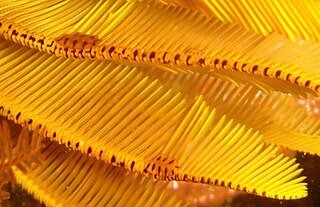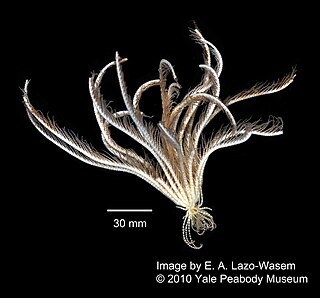
Polychaeta is a paraphyletic class of generally marine annelid worms, commonly called bristle worms or polychaetes. Each body segment has a pair of fleshy protrusions called parapodia that bear many bristles, called chaetae, which are made of chitin. More than 10,000 species are described in this class. Common representatives include the lugworm and the sandworm or clam worm Alitta.

In invertebrates, the term parapodium refers to lateral outgrowths or protrusions from the body. Parapodia are predominantly found in annelids, where they are paired, unjointed lateral outgrowths that bear the chaetae. In several groups of sea snails and sea slugs, 'parapodium' refers to lateral fleshy protrusions.

A chaeta or cheta is a chitinous bristle or seta found on annelid worms, although the term is also frequently used to describe similar structures in other invertebrates such as arthropods. Polychaete annelids are named for their chaetae. In Polychaeta, chaetae are found as bundles on the parapodia, paired appendages on the side of the body. The chaetae are epidermal, extracellular structures, and clearly visible in most polychaetes. They are probably the best-studied structures in these animals. Segments bearing chaetae are called chaetigers.

The Myzostomida or Myzostomatida are an order of small marine worms, which are parasitic on echinoderms, mostly crinoids. These highly unusual and diverse annelids were first discovered by Friedrich Sigismund Leuckart in 1827.

Phyllodocida is an order of polychaete worms in the subclass Aciculata. These worms are mostly marine, though some are found in brackish water. Most are active benthic creatures, moving over the surface or burrowing in sediments, or living in cracks and crevices in bedrock. A few construct tubes in which they live and some are pelagic, swimming through the water column. There are estimated to be more than 4,600 accepted species in the order.
Prosphaerosyllis battiri is a species belonging to the phylum Annelida, a group known as the segmented worms. The species name comes from an Aboriginal word, battiri, meaning 'rough'. Prosphaerosyllis battiri is a species characterized by having only partially fused palps, an unretracted prostomium on its peristomium or showing only slight retraction, the shape of its dorsal cirri and its arrangement of papillae, being numerous anteriorly while less numerous posteriorly. It resembles Prosphaerosyllis semiverrucosa, but its arrangement of dorsal papillae is reversed.
Salvatoria pilkena is a species belonging to the phylum Annelida, a group known as the segmented worms. The species name comes from an Aboriginal word, pilkena, meaning "different", due to its characteristic features. Salvatoria pilkena belongs to a reduced group of species that possess rugose dorsal cirri, contrary to the typical spindle-shaped cirri found in its genus. It also lacks dorsal cirri on chaetiger 2. It resembles Salvatoria swedmarki and S. celiae, differing from pilkena in that the latter has significantly longer proventricles, while its compound chaetae are short and unidentate. At the same time, S. opisthodentata has a similar body and compound chaetae but appears to possess dorsal cirri on its chaetiger 2.
Salvatoria koorineclavata is a species belonging to the phylum Annelida, a group known as the segmented worms. A related species in Australia has been described as Brania clavata and subsequently as Salvatoria clavata. While similar, the Australian species has a longer pharynx and proventricle; at the same time, blades of chaetae are present in the Australian species, with longer and upwards curved spines, which are straight in S. clavata; its pharyngeal tooth is located more anteriorly than in S. clavata. Other global species, like those in the genus Brania, are also similar to S. koorineclavata. Salvatoria californiensis has similar chaetae, with shorter spines and less developed teeth. Its acicula lacks a defined acute tip, and the proventricle is quite shorter, running through 5 segments in S. koorineclavata, with fewer rows of muscle cells. The species name comes from an Aboriginal word, Koorine, meaning "daughter", due to the similarity of the Australian species to the European species of S. clavata.

Sphaerosyllis levantina is a species belonging to the phylum Annelida, a group known as the segmented worms. It was first described from Haifa Bay in the eastern Mediterranean. It is similar to Sphaerosyllis hystrix, and is thought to show a cosmopolitan distribution. Its name derives from its type locality, levantina being the feminine form of a Neo-Latin adjective meaning "pertaining to the region where the sun raises"; the adjective is feminine to agree with the feminine genus name, Syllis being a river nymph in Greek mythology.
Erinaceusyllis cirripapillata is a species belonging to the phylum Annelida, a group known as the segmented worms. E. cirripapillata is characterized by its papillae on its dorsal cirri, one of them being distinctively mushroom-shaped. No species of this genus or Sphaerosyllisis is known to possess this particular kind of papillae. The name of the species refers to these same papillae.
Erinaceusyllis hartmannschroederae is a species belonging to the phylum Annelida, a group known as the segmented worms. This species was previously described in Australia as Sphaerosyllis erinaceus and S. erinaceus erinaceus, a species distributed throughout the globe. These species appear to be a species complex. Previous descriptions stated that the two aforementioned species possess compound chaetae blades which are long and slender. Several subspecies of S. erinaceus were described on the basis of differences in shapes and sizes of their compound chaetae; such differences are enough to consider them as distinct species. The species is named in honour of Gesa Hartmann-Schröder, an expert on syllid species.
Erinaceusyllis kathrynae is a species belonging to the phylum Annelida, a group known as the segmented worms. E. kathrynaen is similar to E. cirripapillata, but lacks characteristic papillae on its cirri. At the same time, Sphaerosyllis perspicax - which according to San Martín (2005) could belong to the genus Erinaceusyllis - is also similar, but its anterior dorsal cirri are inflated at their bases; the eyes and antennae are arranged linearly, and the palps are fused along their length. This species is named in honour of Kathryn Attwood of the Australian Museum.
Sphaerosyllis voluntariorum is a species belonging to the phylum Annelida, a group known as the segmented worms. This species is closely related to Sphaerosyllis bifurcata, Sphaerosyllis bifurcatoides and Sphaerosyllis rotundipapillata, all endemic species to Australia, characterized by having large dorsal papillae, sometimes trilobed, and with shafts of compound chaetae distally bifid. S. voluntariorum is more densely papillated on its anterior segments and has a long subdistal spine on the ventral simple chaetae. This species' name alludes to the volunteers of the Marine Invertebrate section of The Australian Museum, who sorted specimens of syllids that led to the description of this animal.
Sphaerosyllis georgeharrisoni is a species belonging to the phylum Annelida, a group known as the segmented worms. Sphaerosyllis georgeharrisoni is distinct by its large parapodial glands with hyaline material; by its small size; short proventricle; a median antenna that is inserted posteriorly to the lateral antennae; as well as long pygidial papillae. Juveniles of S. hirsuta are very similar to this species. Sphaerosyllis pygipapillata has all of its antennae aligned, a smooth dorsum, while its pygidial papillae are longer and slender. The species' name honours George Harrison, musician who died prior to the species' describing article's publication.
Parapionosyllis winnunga is a species belonging to the phylum Annelida, a group known as the segmented worms. Parapionosyllis winnunga is characterized by the shape of the blades of its compound chaetae, which have a long subdistal spine, in turn much longer than in other cogenerate species. Its species name is derived from the Aboriginal word winnunga, meaning "small".
Ophryotrocha scutellus, is a species of polychaete worm. Live observation of this species in aquarium experiments indicate a bacterial diet. O. scutellus is named after the Latin scutella for “saucer”, due to its flattened disc-like head. Ophryotrocha scutellus has a dorsoventrally rounded and flattened prostomium, similar to O. platykephale, from which this species differs in jaw morphology, the form of its parapodia and the absence of branchiae.
Ophryotrocha craigsmithi is a species of polychaete worm. O. craigsmithi is named after Craig R. Smith. This species is similar to Palpiphitime lipovskyae and O. Platykephale, among others, in having branchial structures dorsally and ventrally. It differs from O. platykephale in the shape of its prostomium and parapodia. Palpiphitime lipovskyae has jaws of both P- and K-type, while no specimens of O. craigsmithi have been found with K-type jaws thus far. Ophryotrocha craigsmithi differs from P. lipovskyae genetically, but also by the presence of a prominent ventral chaetal lobe with a bulging simple chaeta in the former.
Ophryotrocha eutrophila, is a species of polychaete worm. Ophryotrocha eutrophila is named after its habitat, liking organically enriched environments. This species resembles O. puerilis in jaw morphology. O. eutrophila is dimorphic, with males being than females, while possessing K-type maxillae. Ophryotrocha eutrophila, however, differs from O. puerilis in the absence of eyes and the presence of a developed median pygidial stylus. O. eutrophila is also similar to O. fabriae, differing from the latter from its mandibles morphology.

Promachocrinus kerguelensis is a species of free-swimming, stemless crinoids. It was the only member of its genus until several species were discovered in 2023. P. keruguelensis a coldwater crinoid which is found in the seas around Antarctica and surrounding island groups, including under the sea ice.

Myzostoma josefinae is a species of parasitic marine polychaete in the order Myzostomida.







